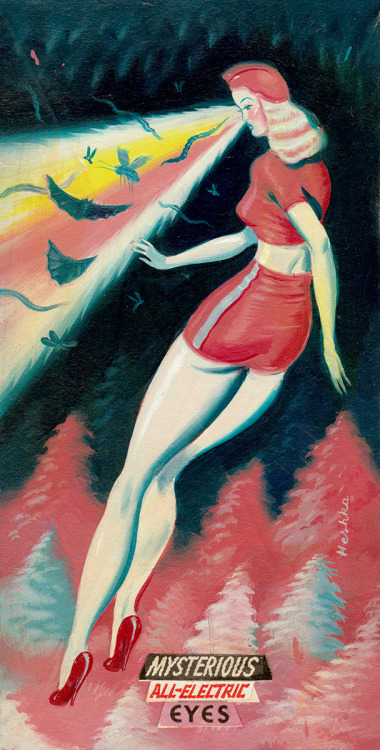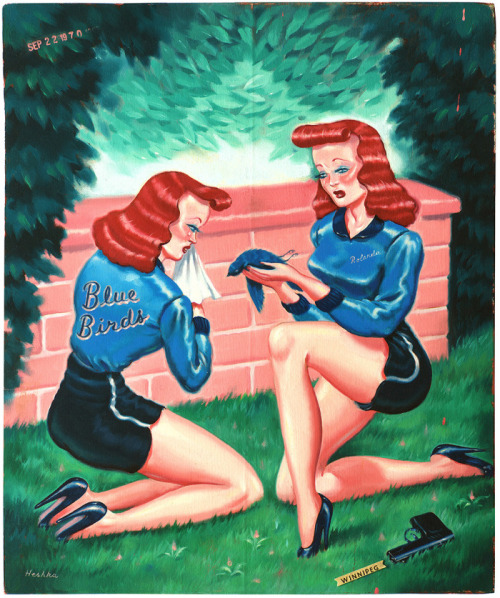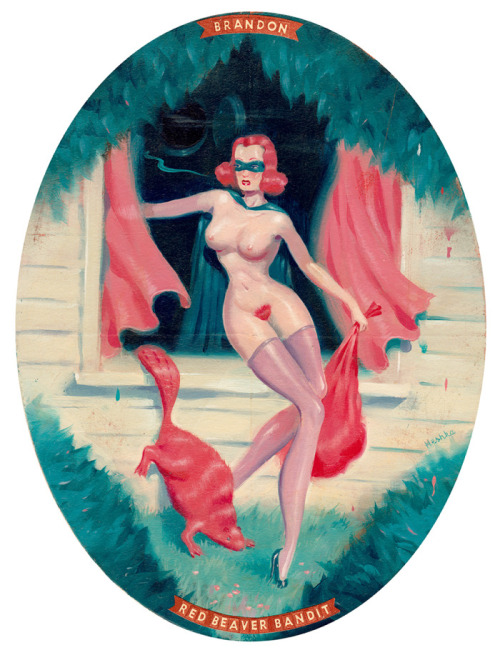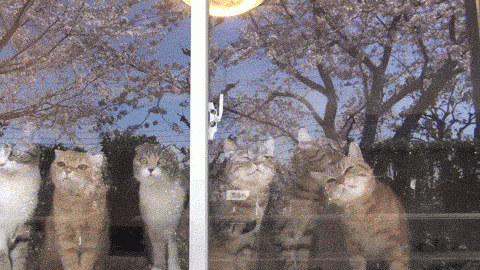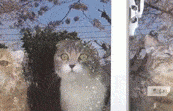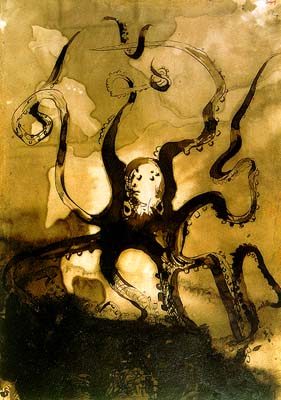Chicken Skin Teddy is a post from meh.ro
Shared posts
prettyyiinpunkk:skindeeptales:Double mastectomy floral...



Double mastectomy floral tattoo
“The response to this piece is incredible. Tattooing is a beautiful and absolutely viable option for concealing or altering scars. When coupled with an artist you’ve researched and feel connected to… taking the reigns and regaining some sort of control can be empowering. There is healing in this!” ( David Allen )
by David Allen - Pioneer Studios - Chicago
This is so beyond beautiful and awesome.
did-you-kno:Never, ever, ever thought of it this way. I’m all...





Never, ever, ever thought of it this way. I’m all about opening people up to ideas, events, facts, stories, and theories they may not have seen/thought about/realized they needed to know, so I thought it was important to share this. Happy Monday! Get yourself to the ball. (
Sound advice
So you’re trying to avoid being killed by a bear policeman? Here’s what to do.
You might be tempted to argue that bears policemen should not be killing people in the first place, but don’t bother; you’re asking for something contrary to their nature.
Christ, not again
So familiar. A police officer claims a black man struggled with him for his weapon, and then the officer had to shoot him to protect himself.
Only problem with the story: a passer-by recorded the incident on his cell phone. The reality was that the black man was running away, the officer fired 8 shots into his back, and then threw his taser onto the ground next to him to fake the evidence of a struggle, in full view of his fellow officers. The video is horrific: after shooting the guy, he’s lying on the ground motionless, and Officer Michael Slagger walks over, yells at him to put his hands behind his back, and cuffs him.
He’d been hit 5 times. He was dead. There was no attempt at resuscitation.
The police killed a man in cold blood, and lied about it.
So, so familiar.
The dead man, Walter Scott, had been stopped for a broken tail light.
You know what? Fuck the police. They are disgracefully screwed up.
Making sense of your cat
CaryI want a Maltese Cheetah.
The title lies. Nothing can make sense of a cat. I don’t even know why I have a cat at home — I blame the brain parasites.
While the mind of the cat is imponderable, at least we can understand coat colors, right? Mine is black with a white spot at the throat. Simple? No, not at all: you need to read this page that categorizes cat coat colors and patterns and sink into the madness. All that variability! The simple genetic models all talk about eumelanin and phaeomelanin expression as covering all the bases, but nope, that’s not sufficient.
I’ve shown this to my genetics students. I’m just teaching introductory genetics, but I occasionally like to point out to them that there is a level at which genetics becomes far more mind-blowing.
Tonight at Curiosity Club: Karl Anderson's DIY Telephone Company

Tonight at Curiosity Club we'll learn about exercises in futility and social good with Karl Anderson! Starts 6pm at the Hand-Eye Supply store, and streaming online on the Curiosity Club homepage.
At first glance, Futel is nothing more than a collection of pay phones installed in publicly accessible locations, no different than the phones found on every street corner. Except one doesn't have to pay to use them. And if the caller doesn't have a human to interact with, one will be provided. And there aren't any pay phones around anymore, anyway.
Find out what we hope to achieve by starting a free telephone network. We will discuss our spiritual ancestors in the phone phreak and mail artist community, as well as our philosophical background in creating useful and nonuseful devices out of discarded junk, and the importance of retaining skills with obsolete interactive technology.

Karl Anderson is a hardware and software experimenter who is good at thinking up projects but bad at predicting whether or not they will be practical. With C.H.U.N.K. 666, he has created amphibious human-powered vehicles out of trash. With the Church of Robotron, he has built a post-apocalyptic training facility, indoctrination center, and reading room based on the tenets of a coin-operated video game.
A conversation with Louise Bourgeois in Incontrollable Beauty
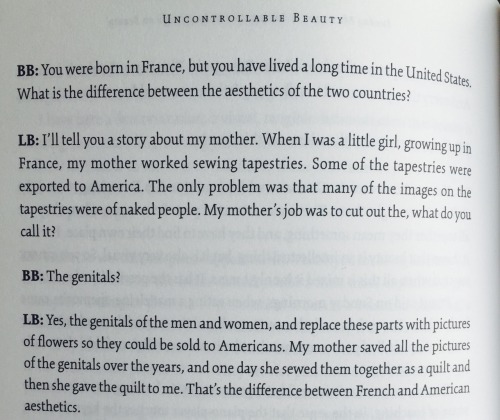
A conversation with Louise Bourgeois in Incontrollable Beauty
darylfranz:ねこあつめにはまってるかのような戦国時代の鎧武者wwwwwwww - ハムスター速報
CaryJapanese Bobtails are War Cats?
ABOUT D@%N TIME

France has enacted a law limiting excessively thin models from working until their BMI reaches a minimum level set forth in the law. Fines and even jail time can be leveled against fashion houses and modeling agents trying to use models that are thinner than the law allows. Its about time we quit letting vanity destroy our little girls.
Wired article on OS/2
CaryThis was my favorite OS...
"Though forgotten, OS/2 never really went away. It wasnt the breakout success on desktops that IBM had hoped for, but thanks to its security and stability it did find a niche on specialized hardware, » more
francavillarts:HAPPY EASTERArt by Francesco FrancavillaHAPPY...

HAPPY EASTER
Art by Francesco FrancavillaHAPPY EASTER, everyone!
Here’s a Easter Egg for y’all :)Cheers,
FF
Back to collage, Merve Ozaslan

Merve Ozaslan | ffffffollow merveozaslan.tumblr.com

Merve Ozaslan | ffffffollow merveozaslan.tumblr.com

Merve Ozaslan | ffffffollow merveozaslan.tumblr.com

Merve Ozaslan | ffffffollow merveozaslan.tumblr.com

Merve Ozaslan | ffffffollow merveozaslan.tumblr.com
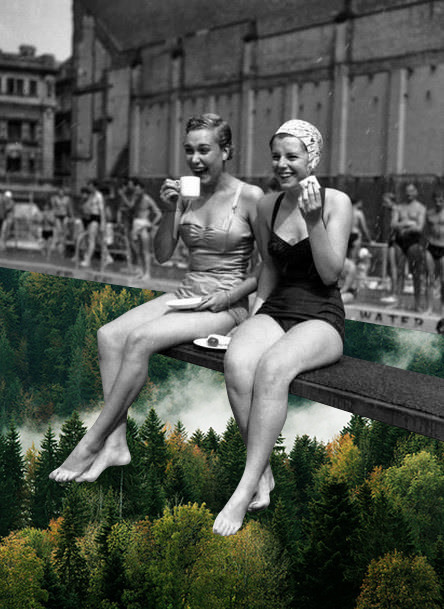
Merve Ozaslan | ffffffollow merveozaslan.tumblr.com

Merve Ozaslan | ffffffollow merveozaslan.tumblr.com
Back to collage, Merve Ozaslan
gacougnol:Masatoshi Naito“Shinjuku Maboroshikei chimeric"...

Masatoshi Naito
“Shinjuku Maboroshikei chimeric"
(“Asahi Camera” published in the April issue 1964)
Reading Lines in Pictures: Why I Teach Visual Literacy
During a recent visit to the Frick Collection, my students were expressively irritated by the lack of wall text that could explain the works of art to them. However, when forced to consider William Turner’s Fishing Boats Entering Calais Harbor, they were able to understand the precarious situation of the boat and intuit the frustration of seeing the proximity of the harbor yet being on a boat unlikely to reach it. They noted the tiny figure on the boat pointing to the enormous swell of the sea and felt the ultimate powerlessness of man in the face of natural forces. Once engaged with the work, the students kept noticing details and elements in the painting, delighting in the tale told through paint. A particular student was later inspired to do some research on Turner and was excited to talk about the differences between the Frick image and Dutch Boats in a Gale currently in the National Gallery, London. She did not start with the historical context nor what others had written about the images, rather, she began with visual analysis.
Joseph Mallord William Turner, Dutch Boats in a Gale 1801
While we are trained to read and consider the significance of the written word, we are often at a loss as to how to read a picture. Frequently, misunderstanding the tired trope of a picture being worth some large number of words, we glance at it, categorize it in relation to something verbal and move on. Of course, viewing images in a museum is not the same as, say, glancing at a photograph online. The lack of learned visual literacy, however, is at the foundation of misunderstanding both.
I often hear unexpected effects of studying art history on student lives: one of my Columbia University undergrads once noted that his relationship with his family had improved vastly once he learned to observe and respond to their body language in a manner he would interpret a painting, rather than in an emotionally charged way.
Read more Reading Lines in Pictures: Why I Teach Visual Literacy at The Toast.
Alana Dee Haynes

©Alana Dee Haynes

©Alana Dee Haynes
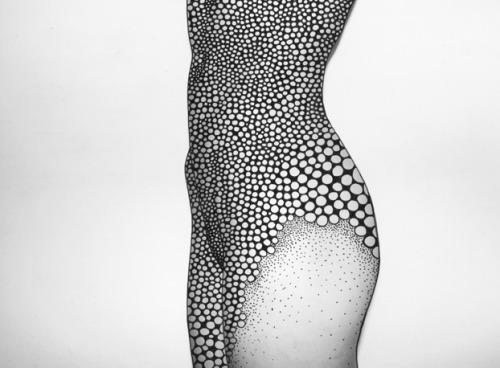
©Alana Dee Haynes

©Alana Dee Haynes

©Alana Dee Haynes
Upgrade Leftover Pizza to Gooey Mini-Calzones with a Waffle Iron

A waffle iron can already help you create some tasty homemade pizza pockets with crescent roll dough, but now you can upgrade your existing leftovers too. In just a few steps, you can turn leftover slices of cold pizza into tasty mini-calzones.
Victor Hugo, painter?
I had no idea that he was skilled at more than writing novels, but apparently his drawings and paintings were quite good. This one is magnificent!
It’s titled “Pieuvre avec les initiales V.H.”, so I guess it’s a kind of self-portrait. Good looking fellow. It’s a good thing I have no talent, because if I did something similar, it would be something out of a nightmare, and you’d all go mad when I showed it.
Brain's 'gender' may be quite flexible: Mechanism that plays key role in sexual differentiation of brain described
Eat the Mango (No, Not That One)

The end of March is still a dead zone for produce here in the Northeast, but in Mexico and further south to Peru, one of the world’s most diverse and most popular fruits, the mango, is beginning to enter one of its two seasons (the other is in early fall). Even though our neighbor to the south is one of the world’s biggest producers of mangoes—and Florida grows a pretty respectable number and hosts what looks like a delightful festival focused on the fruit—the mango is underappreciated and underused in the United States. This should be a crime! We should all be arrested!
If you live in a place without a substantial Indian or Mexican population, there’s a pretty fair chance the only mango you’ve ever seen is the Tommy Atkins: a large, red-green mango with a giant pit and a fibrous interior that gets stuck in your teeth. The Tommy Atkins is one of those accursed fruit varieties, like the Red Delicious apple, that is an insult to its brothers and should be banished from the planet. The Tommy Atkins is the worst possible example of the wonders of the mango: weak in flavor, egregious in texture, and popular exclusively because it is large, easy to grow, and tough enough to withstand transit.
The Tommy Atkins mango was created by Thomas Atkins in Broward County, Florida from a tree planted in 1922. Atkins was very pleased with his shit mango; he thought it would sell well because it is large and pretty and does not bruise easily. He was right, although it took awhile for the variety to catch on. Throughout the early nineteen fifties, Atkins kept trying to get the Florida Mango Forum to approve it; they did not, citing its subpar flavor and texture, but eventually the growers, rather than the tasters, won out. The Tommy Atkins today is by far the most common variety in the U.S., which is embarrassing as heck.
There are thousands of varieties of mangoes, ranging from giant grapefruit-sized mangoes to tiny plum-sized mangoes, dark purple mangoes to delicate golden mangoes, and flat oblong mangoes to nearly spherical mangoes. The textures range from so creamy you need to use a spoon to so crunchy you need to use a fork (or chopsticks), the flavors from crisp and vegetal to heavy and sweet. Most mango varieties do not travel well, unfortunately, and there’s not much of a market in shipping some of the weirder ones all the way from, say, the south of India, where mangoes are as beloved as apples in New York. That said, if you live in a city, or in a place with a healthy representation of certain immigrant groups, there’s a pretty good chance you can find a mango that’ll totally change the way you think about them.
Mexican and Indian markets are, I find, the best places to find good alternate types of mangoes. In New York City, Jackson Heights, in Queens, is a good bet, as is Sunset Park in Brooklyn. And one of the more common non-Tommy-Atkins varieties, the Ataulfo (or Champagne) mango, is just coming into season now. The Ataulfo mango is small, yellow, and kidney-shaped. Its pit is very thin, meaning it’s easy to remove by the only acceptable method, which I’ll get to in a second. The flavor is significantly stronger than a Tommy Atkins; it is much higher in both sugar content and acid, meaning that classic sweet-and-sour mango flavor is kind of supercharged. The flesh, a deep golden yellow, is not fibrous at all; instead it is smooth, creamy, and soft, closer to a ripe avocado than the pear-like stringy flesh of a Tommy Atkins. It is not the best mango in the world—I doubt it wins mango competitions, which totally do exist—but it is the mango that Americans should have been eating all along: an all-purpose mango, a pure expression of mango-ness.
Ataulfo mangoes do not travel as well as Tommy Atkins mangoes, so you have to be a bit more circumspect when shopping for them. When ripe, the Ataulfo is golden all the way around—no green, and no black speckling like on a ripe banana. But no wrinkling, either; if they’re wrinkled on the outside, they’ll be overripe and sort of gross on the inside (though not garbage necessarily!) If you give them a little squeeze with your thumb, they should give just a touch, like a ripe avocado.
So there are a bunch of ways to peel a mango (unlike the kiwi or peach, eating the skin adds nothing at all to the experience of eating a mango and it can sometimes causes an allergic reaction), but most of them are wrong and dumb. Do not use a vegetable peeler, as this will leave you with a slippery fruit that is hazardous to slice, like trying to dice a wet bar of soap. Do not use one of those mango pitters; they waste precious mango flesh and, as always, you should be good at using your knife. If you’re not good with a knife you should use your knife even MORE so you BECOME good with a knife. Stop buying tools that encourage you to not learn this very basic skill.
No, the proper way to slice a mango is, basically, this one, brought to you by a Supermarket That I Never Go To Because It’s Neither Cheap Like Key Foods Nor Charming Like Trader Joe’s. The last step there, where he cross-hatches the mango, I don’t do that one. Instead, I slice the “cheeks” of the mango into three strips. Then I place them skin side down on the cutting board and place my knife just above the skin and my non-knife hand on the cut side of the flesh to hold it in place before sliding the knife along the skin to remove it. I think it’s a little faster, and for whatever reason I like slices of mango rather than cubes, but do whatever you want. Also, Alton Brown has some insane peeling method that involves a magic marker, but that is ridiculous.
An odd thing about mango is that cooking it, generally, does not help it. The aromatics and flavor compounds tend to be destroyed rather than pleasantly altered with the addition of heat. Sometimes that’s fine; ambya sasam, a sort of mango curry, relies on that destruction to de-sweeten the mango so it can become a savory sauce. But mostly, heat tends to lessen the flavor of mango, which is why you don’t see many mango pies or mango crumbles. On the other hand, it has such a high sugar content and such a creamy texture that it does very well in a puree, which is why mango sorbet and mango lassi are so common. This is another way of saying, sorry, the recipes this week are not very elaborate, because really, the best way to eat mango is to just…eat the mango. Still! Here are some things to do with them.
![]()
Chili-Mango Popsicle
Shopping list: Ataulfo mangoes, ground cayenne, salt, lime juice, sugar, popsicle molds
The combination of mango and spice or salt is common pretty much anywhere mangoes grow (except Florida, boo Florida). In Mexico, mangoes are commonly sold on the street doused in vinegary hot sauce and salt, sometimes on sticks, sometimes in plastic ziplock bags, and sometimes as paletas, or popsicles. (Good LORD are Mexicans good at popsicles.) To make: Dice a couple of ripe Ataulfo mangoes and toss in a food processor. (Note: this is one place where an overripe mango will actually be okay! Overripe mangoes are sweeter, so you’ll need to go heavier on the lime and salt, but will work fine in a puree.) Blend thoroughly. This will result in a kind of syrupy sticky-looking substance. Add in a pinch of cayenne, a pinch of salt, and a squeeze of lime. Blend again to mix. Then add in a bit of water to thin it out, maybe a quarter cup per mango. Taste. It should be very sweet, pretty spicy, and a little salty. You may have to add more sugar; the secret to good popsicles is that the mix should always taste sweeter when it’s liquid than you think it should. Pour into popsicle molds and freeze overnight. These are, of course, better in the summertime, which in New York is roughly six months away.
Coconut Brown Rice Pudding With Mango
Shopping list: Ataulfo mangoes, medium-grain brown rice, can of coconut milk, whole milk, brown sugar, vanilla extract, ground cardamom, ground clove, unsweetened shaved coconut
This is a recipe basically stolen from Mark Bittman, who had the brilliant idea to blitz the rice in a food processor, which gives the final pudding a creamier texture more like Thai sticky rice, on which this is a riff. Pre-heat your oven to 300 degrees. Put about a half a cup of regular brown rice in the food processor and hit the “pulse” button maybe three times; you don’t want powder, you just want a little breakage. In a dutch oven, mix the broken rice, a can of coconut milk, one and a quarter cups of whole milk, half a cup of brown sugar, a few healthy pinches of salt, a pinch of cardamom, a pinch of clove, and a few drops of vanilla extract. Put in the oven for forty-five minutes, stir, another forty-five minutes, stir, and about another forty-five minutes should do it. It’s done when it’s still kind of soupy but the rice is cooked through. Let it cool for about half an hour at least and it’ll thicken right up.
While it cools, take a cast iron pan and put it on the stove over medium heat. When hot, toss in a handful of the shaved coconut and toast, tossing frequently, until golden brown. Remove and let cool. Then dice up a bunch of mangoes. You can serve warm but I like it better cold (it’ll take overnight to cool, probably). In a bowl, plop a big scoop of rice pudding. Top with diced mango, the toasted coconut, and, if you want, a pinch of cinnamon.
The Best Mango Recipe
Shopping list: Ataulfo mango
Remove pit and skin from mango by the previously stated approved method. Eat with fingers or, optionally, a fork.
![]()
I worry sometimes that the mango is unappreciated: It commits a few sins against the very American love of convenience, in that it is not a hand fruit and requires a knife to prepare, and also in that it is pretty delicate and perishable and you might have to go to an ethnic market to find it. And yet: mango is perhaps my favorite fruit of all; good ones are easier to find than good peaches, or pears, or apples, at least when you have an easily available supply of Ataulfo mangoes (and more and more supermarkets are starting to carry them!). Their flavor is so intense, a punch in the face of sugar and acid and creaminess and a flavor that we idiots who choose to live in New York still associate with tropical beaches and palm trees. God damn I love mangoes.
Photo by Danielle Scott
Ellen Jewett Sculptures
CaryThey remind me of the animals in Romantically Apocalyptic except hers don't have 3 eyes...
Romantically Apocalyptic - 0
















